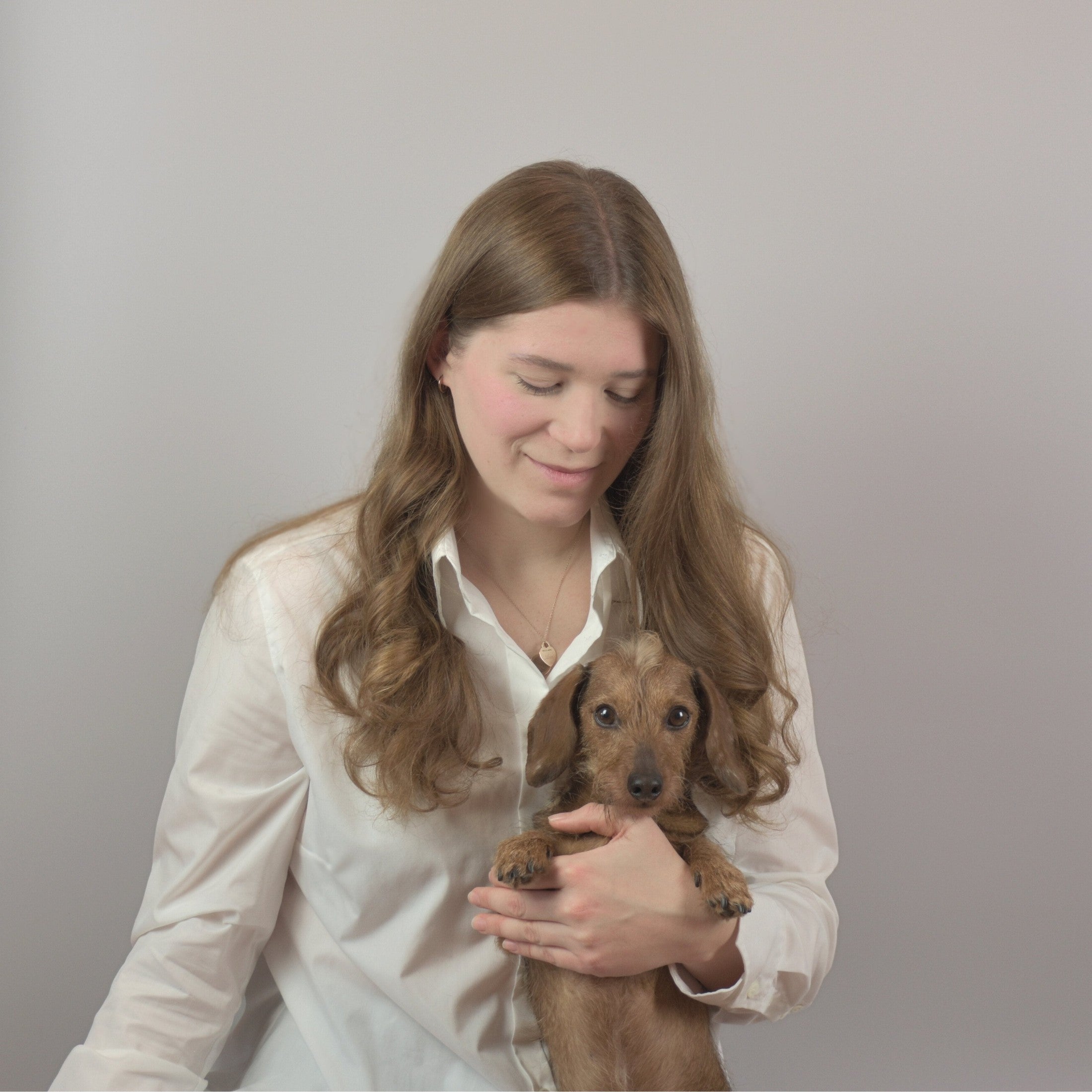Traveling with your dog can be pure joy – but it can also include moments when your four-legged friend becomes restless: new surroundings, unfamiliar noises, the journey itself, hotel stays, and flights. A specially designed soundscape for dogs offers you the chance to give your dog and yourself a little break: a moment of peace, of arriving, of taking a breath together – with high-quality sounds, consciously orchestrated. In this article, you'll learn why dogs react to sounds, how you can create a sound journey for your dog at home or on the go, what benefits it offers – and how it elevates your travel experience with your dog to a new, stylish level.
Table of contents
- Why dogs react to sounds – and what that tells us
- What is a sound journey for dogs? A journey of relaxation, trust, and connection.
- The effect of music, frequencies and rhythm on the dog's body
- How to create your own sound journey at home or while traveling
- Sound journeys while traveling: How sounds can help your dog feel safe on the go
- Playlist ideas and sound sources for quiet moments with your dog
- Conclusion: A moment of silence that connects.
Key take-aways
- Dogs possess a fine hearing and perception system – sounds affect body and mind.
- A carefully designed sound journey strengthens calmness, connection and well-being – even on the go.
- Scientific studies show that classical, calm music can reduce stress in dogs.
- You can easily create a sound journey for your dog at home or while traveling – with minimal resources and high-quality care.
- The effect is not just short-term relaxation, but a ritual that makes your travel experiences with your dog stylish and relaxed.
Why dogs react to sounds – and what that tells us
Dogs hear differently than we do. Their ears perceive frequencies beyond our hearing range – many sounds that we barely notice can be intense for a dog. Therefore, sounds can be used intentionally to have a specific effect: calming, supportive, and creating a pleasant atmosphere.
For example, studies show that dogs in shelter environments spend more time resting, bark less, and become calmer when classical music is played . Similarly, a biometric study of service dogs showed that music specifically composed for dogs ("canine-designed music") resulted in lower heart rate and respiratory rates than classical music or no sound at all. This illustrates that sounds are not just a gimmick, but can specifically influence your dog's well-being .
For you as a dog owner, this means: By consciously creating a sonic environment – in the car, in the hotel room, before falling asleep – you offer your dog an additional source of security and calm. The perception of sound becomes part of the travel routine and ritual, which soothes your dog and strengthens your bond.
What is a sound journey for dogs? A journey between relaxation, trust, and connection.
A "sound journey for dogs" is more than just playing music. It's a consciously designed experience – in which your dog, you, and your surroundings pause briefly, arrive, and connect. It's about this:
-
To create an atmosphere of peace and relaxation
-
To consciously foster the bond between you and your dog
-
to compensate for stress or travel stimuli
-
Quality, style, and a luxurious feel — fitting for a high-quality lifestyle with a dog
Essentially, you use sound, space, time, and your conscious presence to give your dog a moment – and yourself as well. Imagine: in a stylish hotel room, the lights softly dimmed, a luxurious blanket for your dog, high-quality materials (reflecting your brand values like robust leather, recycled wool…) – and in the background, a carefully selected sound sequence that soothes your dog. That's precisely what a sound journey means in this context.
The term "journey" here refers not only to geographical travel, but also to a small inner journey – an acoustic ritual that guides your dog from external stimuli to inner peace. Especially for nervous dogs who react to many stimuli, such a sound journey can be a source of calm.
The effect of music, frequencies and rhythm on the dog's body
What mechanisms are at work behind the scenes? Here's an overview:
Hearing and perception profile of a dog
Dogs not only hear louder noises earlier, but also higher frequencies than humans. This means that any effective sound should be sensitive to your dog's hearing range – avoid loud, sudden noises, use frequencies deliberately, and choose a comfortable volume. Studies show that excessively loud or sudden noises can cause stress.
Scientific evidence
-
A review study concludes that classical music has had a calming effect on dogs in many studies – more time lying down, less time standing, less barking.
-
A specific biometric study with service dogs showed that "canine-designed music" led to lower pulse rates and better heart rate variability values than classical music or no music.
-
Practical recommendations: Gentle, even rhythms (e.g., approx. 50–60 BPM), little instrument "fuzz", clear sound images, low volume.
Application for your dog
- Make sure the volume is moderate: dogs are more sensitive to noise.
- Use sound sequences with a calm tempo and little acoustic complexity – ideal for falling asleep, arriving, or during the relaxation phase.
- Consider individuality: Not every dog reacts the same way – observe posture, breathing rate, and resting behavior.
- Establish a routine: Regular sound sessions help the dog to associate the acoustic environment with safety.
How to create your own sound journey at home or while traveling
Now for the practical implementation – how can you create a high-quality sound journey experience for your dog using simple means? Whether at home or on the go – with style and tranquility.
Preparing the site
-
Choose a quiet room or corner in your hotel room or vacation rental. Reduce sources of disturbance (television, noisy streets, etc.).
-
Pay attention to comfortable materials: e.g. a soft blanket for the dog, a familiar cover for its place.
-
Ensure comfort: The dog has a lying position (e.g., dog bed or cushion), and the space should also offer you comfort – perhaps an armchair or a lounge seat.
-
Light, scent and atmosphere: Warm light, possibly a subtle scented candle (dog-friendly!), create a calm atmosphere.
Technology & Sound Materials
-
Speaker setup at home; on the go, a high-quality Bluetooth speaker may suffice. Pay attention to good sound quality: bass response and balanced reproduction.
-
Choose a playlist or sound sequence that starts quietly, unfolds slowly and ends gently – about 20-30 minutes.
-
Keep the volume moderate and consistent: Avoid large volume fluctuations.
-
Optional: Use headphones for yourself – this way you can be mindful and relaxed, and your dog will consciously feel your presence.
The course of the sound journey
-
Arrival (approx. 5 minutes): You and your dog sit down together, a quiet greeting, the dog may then sit down.
-
Warm-up (approx. 5 minutes): Quiet sound introduction, brief moment of arrival, perhaps a gentle touch, calm breathing.
-
Main phase (approx. 15–20 minutes): The sound journey is underway – you sit relaxed beside it, allow your dog to lie down, breathe, if necessary quietly seek eye contact or simply let go.
-
Closing (approx. 5 minutes): The sound becomes calmer, the light becomes even softer, you consciously end the session, give your dog a nice blanket or a rest period.
-
Afterglow: Perhaps a quiet moment, a walk afterwards, or a quiet activity – so that the peace can have an effect.
Traveling with a dog: Special considerations
-
In your hotel room or holiday apartment: Turn off all sources of sound interference, and if possible, use a headphone/speaker combination to fully immerse yourself in the experience.
-
In the car before departure or after arrival: A short 10-minute sound journey in a quiet vehicle can help the dog to "unload" or arrive.
-
During flights or waiting times: Use headphones or a quiet sound source so that the dog does not experience constant stress.
-
Maintain mobility: A compact setup bag with your speaker, blanket, relaxation cushion, small treats – so the ritual can continue even on the go.
-
A small ritual: "Check-in" of your dog – gentle conversation, hand on fur, eye contact – before the sound journey begins.
Sound journeys while traveling: How sounds can help your dog feel safe on the go
Traveling with a dog presents unique challenges: new surroundings, unfamiliar noises, different routines – all of which can unsettle your dog. This is where a sound journey comes in: it creates an acoustic home, a haven of peace that your dog connects with you.
Why it's especially useful when you're on the go
-
High stimulus density: airport noise, vehicle movement, new environment – all of this can create stress.
-
Limited space for retreat: Hotel rooms or holiday apartments often offer few familiar elements; the sound journey creates a familiar ritual.
-
Shared bond: Sitting together quietly in unfamiliar surroundings strengthens your connection – this provides security.
-
Can be used preventively: Before a walk, before sleeping or after arrival – a short sound session helps to switch on or off.
Practical travel tips
-
Arrival phase: By car or train: Start the sound journey before reaching your destination – 10–15 minutes of calm sounds will help the dog “arrive”.
-
Hotel or room ritual: Before going to sleep, take a sound journey so that your dog knows: Now it's quiet time.
-
Stopovers: During waiting times or transit: A mobile sound journey with headphones/tablet helps to reduce overstimulation.
-
Upon returning home: A short sound journey as an “arrival ritual” after the trip.
Special considerations for nervous dogs
If your dog is prone to noise sensitivity or travel anxiety:
-
Set up the ritual at home before the trip – so that the sound journey becomes recognizable.
-
Choose a familiar playlist that your dog associates with positive things.
-
Pay attention to your volume and expression of calmness – your dog senses your mood.
-
If necessary, add a familiar blanket or toy that is associated with the travel routine.
Playlist ideas and sound sources for quiet moments with your dog
To help you get started right away, here's an elegant overview with audio examples that you can use or as inspiration for your own compositions:
| No. | Title / Description | Special features & use | Audible at* |
|---|---|---|---|
| 1 | "Relaxing music for dogs - 432 Hz, cricket chirping" | Calm nature and low-frequency sounds, ideal for evening rituals | Platforms like YouTube/Spotify ("Dog Relaxation 432Hz") |
| 2 | “Sound Bath for Dogs – Singing Bowls & Gongs” | Gentle vibrations with a deep effect – perfect after travel | Platforms like YouTube/Spotify (“Sound Bath for Dogs”) |
| 3 | “Canine-Designed Music – Pet Acoustics” | Specifically tailored to a dog's hearing profile; biometrically effective | PetAcoustics |
| 4 | "Sound Journey at Home - Solo Piano, 50-60 BPM" | Minimalist, quiet, ideal for relaxing together | Platforms like YouTube/Spotify (“Dog Calm Piano”) |
Tips for use
-
Change the playlist occasionally – studies show that dogs can become “used to” a sound and the effect diminishes.
-
Use high-quality headphones or speakers, because sound quality makes a big difference.
-
Optional: Supplement with your own recordings of your voice: for example, a calm greeting or instructions – this will make the sound even more personal.
Conclusion: A moment of silence that connects.
A sound journey for dogs is not just a game – it's a conscious, high-quality ritual that can bring more peace, security, and connection to you and your dog, whether you're traveling or at home. By consciously shaping sound, space, and time, you transform ordinary moments into stylish retreats – where your dog can unwind, you can relax, and your shared travel experience deepens. Start small – with a calming playlist, a comfortable resting place, and a stylish setting – and feel how sound adds a new dimension to your canine journey.






